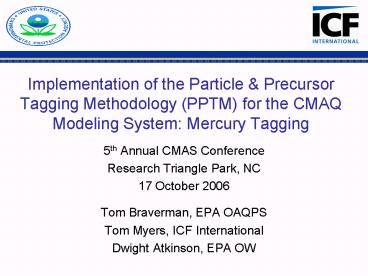Implementation of the Particle PowerPoint PPT Presentation
1 / 18
Title: Implementation of the Particle
1
Implementation of the Particle Precursor
Tagging Methodology (PPTM) for the CMAQ Modeling
System Mercury Tagging
EPA
- 5th Annual CMAS Conference
- Research Triangle Park, NC
- 17 October 2006
- Tom Braverman, EPA OAQPS
- Tom Myers, ICF International
- Dwight Atkinson, EPA OW
2
Presentation Outline
- Background objectives
- Overview of PPTM
- Implementation of PPTM for mercury in the CMAQ
model - Testing example results
- Summary
3
Background Objectives for Mercury Tagging
- Atmospheric deposition of mercury is a source of
mercury contamination in surface waters - As of 2005, more than 6,000 bodies of water were
identified as mercury impaired and more than
2,000 were issued mercury fish advisories - Key objective of mercury tagging is to quantify
the contribution from selected sources/source
categories to mercury deposition for bodies of
water, hydrologic zones, and watershed regions
4
Overview of PPTM Concepts
- Emissions (or initial/boundary condition) species
are tagged in the emissions (or IC/BC) files and
continuously tracked throughout the simulation - Tags can be applied to source regions, source
categories, individual sources, initial
conditions, and/or boundary conditions - PPTM quantifies the contribution of tagged
sources to simulated species concentrations
deposition
5
Overview of PPTM Concepts
- Within the model, tagging is accomplished by the
addition of duplicate species (e.g., HG_t1,
HG_t2) - Tagged species have the same properties and are
subjected to the same processes (e.g., advection,
chemical transformation, deposition) as the
actual species - Base simulation results not affected by tagging
6
Overview of PPTM Attributes and Limitations
- Attributes
- Straightforward and true to modeled results
(limited normalization or partitioning
assumptions) - Technique has been extensively tested and refined
in REMSAD (over a period of 7 years) before being
incorporated into CMAQ - Limitations
- Currently number of tags is limited by of
output species allowed by CMAQ (hard-coded in
libraries) - Mercury tagging applied separately (currently)
- CMAQ run times and file sizes are increased
7
Overview of PPTM Attributes and Limitations
- Other Notes
- Provides information about contribution, and not
response to changes in emissions - Difference between sum of all tags and overall
concentration gives an estimate of the
uncertainty effects in the contribution estimates - Tags are additional species in the model, which
allows postprocessing of the outputs using
standard methods (applicable for any species)
8
Implementation of PPTM for CMAQ Mercury
- CMAQ version 4.5.1
- Tagged elements include
- HG, HGIIGAS, HGIIAER, APHGI, APHGJ
- Key considerations/assumptions
- Linear processes simulated directly (e.g.,
advection, dry deposition) - Potentially non-linear processes (e.g., gas-phase
chemistry, aqueous chemistry, particle dynamics)
calculated for total species and apportioned to
tags - Simulation always includes the overall species
tag and may include up to 7 additional tags
individual tags do not have to add up to the
overall tag
9
Implementation of PPTM for CMAQ Mercury
- CPU requirements increased by approximately 30
percent for 3 tags - Documentation/users guide available from EPA or
ICF as follows
Douglas, S., T. Myers and Y. Wei. 2006.
Implementation of Mercury Tagging in the
Community Multiscale Air Quality (CMAQ) Model.
Prepared for EPA, OAQPS, Research Triangle Park,
NC. ICF International, San Rafael, California
(06-051).
10
Testing of PPTM for Mercury Model Inputs
- 2001 Penn State mesoscale meteorological model
version 5 (MM5) - 1999 NEI mercury emissions inventory, except 2002
NEI for MWI - 2001 criteria pollutant emissions
- 36 km horizontal grid square resolution
- 14 vertical layers (surface layer 38 meters)
- Harvards GEOS-CHEM global model used for inflow
of pollutants to the modeling domain (varied
horizontally and vertically every three hour
period)
11
Testing of PPTM for Mercury
- Limited period test runs used to confirm
- Base simulation results are the same w/ w/o
tagging - Location and footprint of tags is reasonable
(consistent with tag specifications met
conditions) - Various types of tags (geographic, source
category combinations, per requested examples)
work correctly - One-month test runs (July 2001)
- w/o tagging
- source-category tags (T1EGU, T2other, T3IC/BC)
12
Example CMAQ PPTM Mercury Tagging Results
Elemental Hg
Tag 1 EGU
CMAQ Base
Tag 2 Other
Tag 3 IC/BC
13
Example CMAQ PPTM Mercury Tagging Results
Divalent Hg
Tag 1 EGU
CMAQ Base
Tag 2 Other
Tag 3 IC/BC
14
Example CMAQ PPTM Mercury Tagging Results
Particulate Hg
Tag 1 EGU
CMAQ Base
Tag 2 Other
Tag 3 IC/BC
15
Example CMAQ PPTM Mercury Tagging Results Dry
Deposition
Tag 1 EGU
CMAQ Base
Tag 2 Other
Tag 3 IC/BC
16
Example CMAQ PPTM Mercury Tagging Results Dry
Deposition
Difference/ uncertainty
IN26
PA13
MD13
FL34
17
Example CMAQ PPTM Mercury Tagging Results Dry
Deposition
IN26
PA13
Results vary considerably by site
FL34
MD13
18
Summary
- Mercury tagging has been implemented in version
4.5.1 of CMAQ - Mercury tagging can be used to track the fate of
mercury emissions from selected sources and to
quantify the contribution of the emissions to
CMAQ-derived concentration and deposition
estimates - Initial test results indicate that numerical
effects (uncertainties) are small, compared to
contribution estimates - Plan to perform further mercury tagging work for
other months and at 12 km grid square resolution

